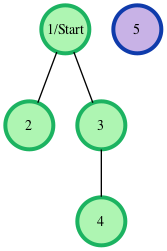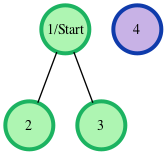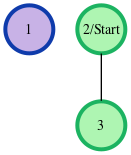Breadth First Search Shortest Reach
Hazrat Ali
You will be given a number of queries. For each query, you will be given a list of edges describing an undirected graph. After you create a representation of the graph, you must determine and report the shortest distance to each of the other nodes from a given starting position using the breadth-first search algorithm (BFS). Return an array of distances from the start node in node number order. If a node is unreachable, return for that node.
Example
The following graph is based on the listed inputs:

// number of nodes
// number of edges
// starting node
All distances are from the start node . Outputs are calculated for distances to nodes through : . Each edge is units, and the unreachable node has the required return distance of .
Function Description
Complete the bfs function in the editor below. If a node is unreachable, its distance is .
bfs has the following parameter(s):
- int n: the number of nodes
- int m: the number of edges
- int edges[m][2]: start and end nodes for edges
- int s: the node to start traversals from
Returns
int[n-1]: the distances to nodes in increasing node number order, not including the start node (-1 if a node is not reachable)
Input Format
The first line contains an integer , the number of queries. Each of the following sets of lines has the following format:
- The first line contains two space-separated integers and , the number of nodes and edges in the graph.
- Each line of the subsequent lines contains two space-separated integers, and , that describe an edge between nodes and .
- The last line contains a single integer, , the node number to start from.
Constraints
Sample Input
2
4 2
1 2
1 3
1
3 1
2 3
2
Sample Output
6 6 -1
-1 6
Explanation
We perform the following two queries:
-
The given graph can be represented as:

where our start node, , is node . The shortest distances from to the other nodes are one edge to node , one edge to node , and an infinite distance to node (which it is not connected to). We then return an array of distances from node to nodes , , and (respectively): . -
The given graph can be represented as:

where our start node, , is node . There is only one edge here, so node is unreachable from node and node has one edge connecting it to node . We then return an array of distances from node to nodes.
Solution